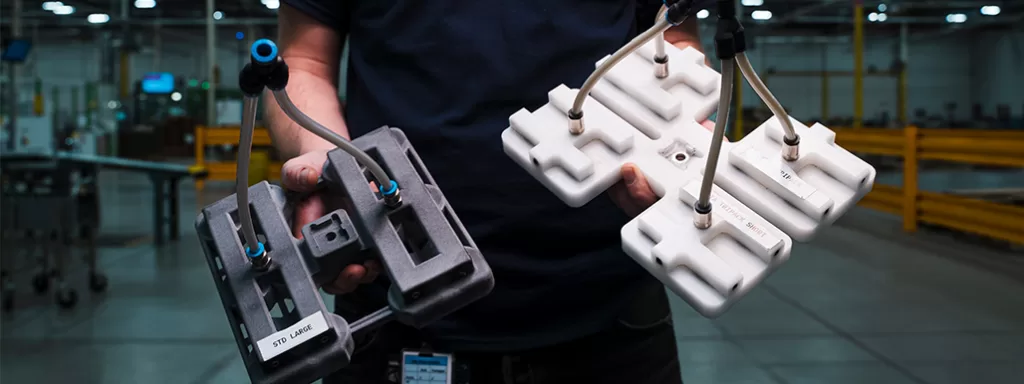Revolutionizing Product Development in the Electrical Industry
The landscape of product development has evolved remarkably with the advent of cutting-edge technologies. One of the notable breakthroughs in this domain is HP’s Multi Jet Fusion (MJF) 3D printing technology, particularly when paired with the versatile PA12 material.
HP’s MJF 3D printing technology stands out due to its speed, precision, and cost-effectiveness. At its core, MJF uses a fine powder material and a fusing agent to create parts layer-by-layer. This method results in strong, durable, and finely detailed prints.
Polyamide 12 (PA12) is an ideal choice for 3D printing, featuring high tensile strength, impact resistance, and good elongation. It also exhibits excellent chemical resistance and low moisture absorption, making it suitable for robust end-use parts. When combined with MJF technology, PA12 can produce parts that not only perform well but also display excellent surface finish and fine detail—crucial for creating cases and housing that protect sensitive electrical components.

IThe Electrical Industry: A Perfect Fit
In the electrical industry, robust and precise housing and casings are not just a luxury, but a necessity. Here’s how MJF and PA12 bring specific benefits to this field:
- Enhanced Electrical Insulation: PA12 acts as an excellent insulating material, crucial for protecting components from electrical surges and interferences. This quality is vital for maintaining safety and performance standards in the electrical industry.
- Durability and Safety: Electrical housings often require materials that can withstand high impact and thermal stresses. The durability offered by the MJF-PA12 combination ensures long-lasting protection, reducing the risk of damage and ensuring user safety.
- Complex Wiring Accommodations: Electrical enclosures must accommodate complex wiring and connectors. MJF allows for designing intricate internal geometries and custom-fit compartments, ensuring efficient space utilization and seamless integration with electrical components.
IReal Life Cases
Case Study: Norma Additive Manufacturing
Norma Additive Manufacturing utilized HP MJF and PA12 to produce custom cases and housings for electrical products with previously unattainable characteristics. Here’s how:
- Rapid Prototyping: Their design teams could iterate faster, testing various configurations and geometries without the lengthy lead times of traditional manufacturing methods. This rapid prototyping allowed for swift feedback and adjustments, ensuring optimized final designs.
- Functional Prototypes: The ability to produce functional prototypes that performed similarly to production parts was a significant advantage. For electrical products, it was pivotal to test how housings protected components under real-world conditions, gaining invaluable insights into performance and durability.
- Customization: Norma could easily customize parts for their clients, tailoring specific features and dimensions to meet unique needs. This flexibility was particularly beneficial for bespoke projects where traditional methods would be cost-prohibitive.
Read the whole case here.

Case Story: Hoffmann+Krippner
Hoffmann+Krippner capitalized on MJF and PA12 to innovate their input device solutions specifically for the electrical industry. Here’s their journey:
- Complex Geometries for Electrical Enclosures: HP MJF allowed Hoffmann+Krippner to incorporate complex geometries and intricate internal features that are challenging or impossible with traditional methods. They could create cases and housing with integrated mounting points, cable management channels, and ergonomic shapes, enhancing both functionality and user experience.
- Enhanced Aesthetics and Functionality: The excellent surface finish provided by MJF and PA12 enabled Hoffmann+Krippner to deliver not just functional but aesthetically pleasing products. Electrical housings were not only reliable but also visually integrated into sophisticated electrical systems.
- Sustainable Production: Embracing HP MJF meant less material waste and more efficient use of resources compared to traditional subtractive manufacturing. Hoffmann+Krippner could contribute to sustainability goals while maintaining the highest quality standards for their products.
Read the complete case here.

IThe Future is Bright
The collaboration between HP’s MJF technology and PA12 has opened doors to unprecedented innovation in product cases and housing within the electrical industry. For Norma Additive Manufacturing and Hoffmann+Krippner, this technological synergy has resulted in faster time-to-market, reduced costs, and the ability to offer more customized, robust, and safe solutions to their clients.
As more industries recognize the potential of advanced 3D printing technologies, especially within the electrical sector, we can anticipate a paradigm shift. The success stories of Norma and Hoffmann+Krippner underscore the limitless possibilities that HP MJF 3D printing and PA12 bring to the table. The future of product development not only looks promising but is already here, reshaping our world one layer at a time—in the most electrically safe way possible.